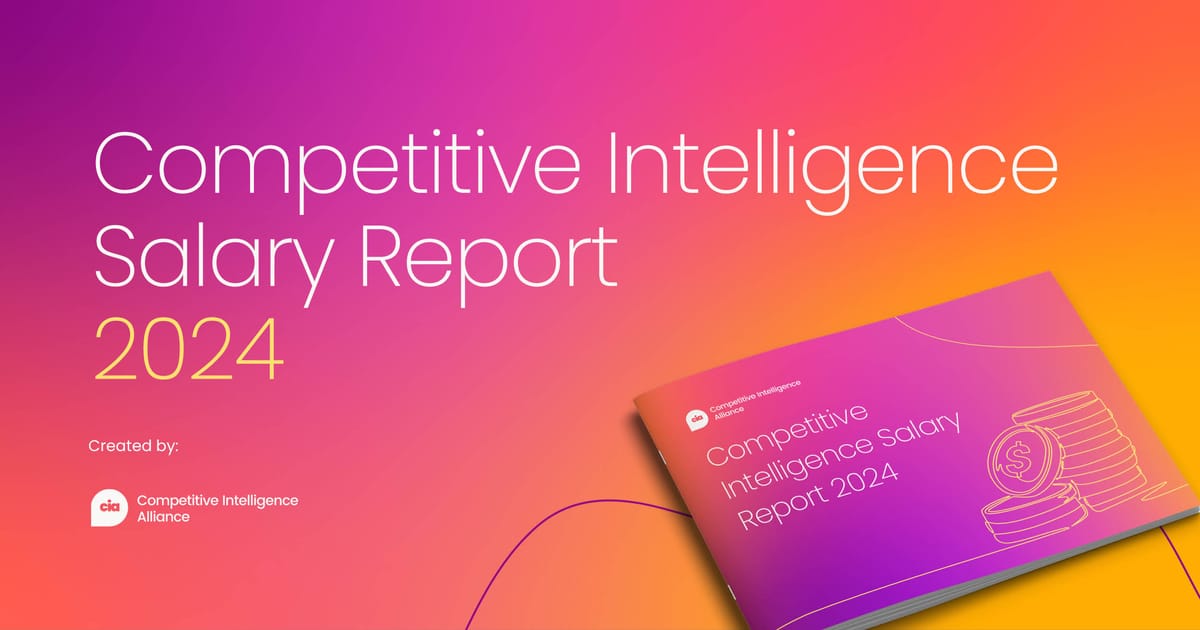If you’ve ever wondered whether you’re getting paid what you deserve as a competitive intelligence (CI) pro, then the 2024 Competitive Intelligence Salary Report is here to spill the tea.
Spoiler alert: some regions and roles are definitely banking more than others. But don’t worry, we’ve got all the stats so you can size up where you stand.
Let’s take a peek:
- Average salary worldwide: CI professionals are pulling in an average of $115,065 a year before taxes.
- Regional dominance: North America’s leading the charge, with base salaries an eye-popping $62,643 higher than Europe – the second-highest-paying region. Want another shocker? Directors in Asia are earning less than analysts in Europe.
- Top earners: Directors and those clocking over 60 hours a week are making the most.
- Hybrid roles: They're at the top of the pay scale, offering an average base salary of $120,059.
- Industry insights: Aviation and aerospace is flying high as the top-paying industry, where CI pros are averaging a massive $203,577.
- Gender gap alert: Women in competitive intelligence are still earning 19.1% less than their male counterparts.
- Salary dissatisfaction: Nearly half of CI pros are unhappy with their pay, with an average salary satisfaction score of just 3.5 out of 10.
Now, let’s dive deeper into each of these key takeaways and what they mean for you.
Global CI salaries: An overview
Let’s talk numbers – globally, competitive intelligence professionals are earning an average base salary of $115,065. Not bad, right?
But, as you’d expect, where you’re based makes a massive difference. North America is at the top of the compensation ladder, with CI pros earning an average base salary of $149,034. That’s a cool $62,643 more than their counterparts in Europe, the next highest-paying region.
Asia and Africa, however, are a different story. Salaries in these regions are significantly lower, with CI professionals in Asia bringing in an average base salary of $40,398, and those in Africa seeing even less at $18,000. The disparities are striking – especially when you realize that directors of competitive intelligence in Asia often earn less than analysts in Europe.
It’s not just about geography, though – company revenue plays a role, too. If you’re working at a company pulling in $100M–$249M annually, you could be earning nearly 40% more than someone at a $50M–$99M company.
Bottom line? Location and company size are two of the biggest factors impacting your paycheck.
Director-level positions and long hours: Leading the way in earnings
Director-level roles are at the top of the salary scale for competitive intelligence professionals. In North America, directors of competitive intelligence are earning an average salary of $171,077, making them some of the highest-paid in the field. Seniority clearly pays off when it comes to CI compensation.
On a separate note, putting in longer hours can also boost your paycheck – those working more than 60 hours per week see some of the highest salaries across all roles, making an average of $177,500.
However, working more hours doesn’t necessarily equate to higher pay. Those clocking in 16 to 25 hours a week actually earn slightly more than those plugging for 50 to 60 hours.
Hybrid roles: The new top earners
With an average base salary of $120,059 and total yearly compensation reaching $137,903, professionals who split their time between the office and remote work are cashing in more than their fully remote or in-office counterparts.
Interestingly, those who work entirely from the office are the lowest earners, with a stark 46.9% gap compared to hybrid workers.
This shift highlights the growing value placed on flexibility in the workplace. Hybrid roles seem to strike the perfect balance between in-office collaboration and the autonomy of remote work, making them a sweet spot for both job satisfaction and compensation.
Aviation and aerospace: The highest-paying industry
If you’re looking to maximize your earning potential as a competitive intelligence professional, the aviation and aerospace industry is where you want to be. With an average salary of $203,577, this sector tops the charts for CI pay, far outpacing other industries.
While other industries like market research ($180,010) and restaurants ($185,038) also offer attractive compensation, aviation and aerospace leads the way by a significant margin. The high salaries reflect the critical need for deep insights and strategic intelligence in an industry where the stakes are high and innovation and competition are fierce.
CI professionals in industries like packaging and containers ($35,003) or machinery ($55,054) are earning far less, showing a stark contrast in how different sectors value competitive intelligence.
In short, if you’re looking to make a strategic career move, you might want to start brushing up on your aviation and aerospace knowledge.
Gender pay gap: A persistent issue
The 2024 Salary Report makes it clear that the gender pay gap in competitive intelligence is a stubborn reality.
On average, women in CI earn 19.1% less than men do. That’s a significant difference, with men earning an average of $124,297, while women bring in $100,572. The gap becomes even more pronounced when you look at the median salary – $140,000 for men versus $105,753 for women, a staggering $34,257 difference.
This disparity isn’t limited to one region, either. In Europe, the pay gap is particularly striking, with men earning 70.8% more than women on average. While there are exceptions, like the Middle East where women out-earn men by 51.5%, these cases are rare.
Even when you break it down by job title, men consistently out-earn women, whether they’re competitive intelligence analysts or directors. It’s a worrying trend that shows the gender pay gap remains a significant barrier in the industry. For companies committed to fairness and inclusivity, addressing this issue needs to be a top priority.
Can’t get no (salary) satisfaction
Salary dissatisfaction is widespread among competitive intelligence professionals, and the 2024 Salary Report highlights just how deep the issue runs.
Nearly half of all respondents (48%) are unhappy with their compensation, and the average salary satisfaction score sits at a low 3.5 out of 10, highlighting the gap between pay expectations and reality for many CI pros.
The discontent is most pronounced among CI analysts, with a staggering 85.7% expressing dissatisfaction. At the director level, while there’s more ambivalence, it’s still not a glowing picture – 73.3% of directors feel indifferent about their pay, with none rating their satisfaction higher than a seven.
This widespread dissatisfaction raises questions about how well compensation reflects the value that CI professionals bring to their organizations. With almost half of practitioners feeling underpaid, salary satisfaction is clearly a pressing issue that could impact retention and morale across the industry.
Conclusion
The 2024 Competitive Intelligence Salary Report offers a vivid snapshot of the evolving industry pay trends.
From director-level roles leading the charge in pay to hybrid positions becoming the new sweet spot, it’s clear that where you work, how you work, and the role you hold all play a pivotal part in determining your earnings.
However, the persistent gender pay gap and widespread dissatisfaction with compensation show that there’s still work to be done to ensure fair and competitive pay across the board.
If you’re a CI professional looking to advance your career or simply want to know where you stand in relation to your peers, this report is packed with insights to help guide your next move.
Want to dive deeper into the data? Download the full 2024 Competitive Intelligence Salary Report for all the details and to see where you can optimize your earning potential.






.png?v=4917c1c27c)